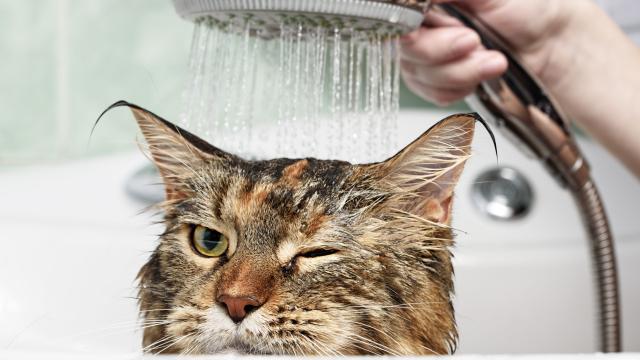There are many things about owning a cat that are easy and stress-free. Cats are solitary creatures, and don’t generally require the same levels of constant attention and emotional support as dogs. They’re wanderers whose nocturnal sleep cycles give them obscene bursts of energy very late at night. They poop in a box in the corner and do not ask to be taken outside to pee at 5 a.m. But bathing a cat — any cat — can feel like a Sisyphean task as your feline buddy wriggles, squirms, and bears their claws in protest at the first sign of sloshing water and soapy suds.
This isn’t so much a possibility as a given; most cats don’t like baths, so your efforts to clean them with soap and warm water will likely be met with fierce opposition. Cats clean themselves all the time, so definitely take some time to consider whether it’s even necessary for you to bathe your cat. If it has to be done, here’s how you can make it relatively easier. Ish.
[referenced id=”1038918″ url=”https://www.lifehacker.com.au/2020/12/how-to-safely-take-car-rides-with-your-dog/” thumb=”https://www.gizmodo.com.au/wp-content/uploads/sites/4/2020/12/04/anlmva874klfm5bd82am-300×169.jpg” title=”How to Safely Take Car Rides With Your Dog” excerpt=”Travelling with your dog can eliminate the stress of kennels or paying someone to dog sit, and as more people are opting for long drives instead of flying, there are few things worth considering when bringing your dog along for the ride. I spoke with Gabriel Riesco, founder of Pawmos…”]
Why would you need to bathe your cat?
Cats are constantly bathing themselves, so you’ll only really need to consider bathing yours if the kitty gets into something they shouldn’t, or has some sort of ailment or infection they can’t clean themselves. As Preventivevet explains, if your cat has a fungal infection like ringworm, fleas, or something extraneous like motor oil or a cleaning product coating their fur, you’ll need to bathe them.
Older cats and obese cats might need baths more often too, as Preventivevet explains:
These cats may be unable to groom themselves properly and fully, and so may need occasional baths to keep their coat and skin healthy. Arthritic cats may even appreciate the bath, as the warm water and the massage of lathering the shampoo can actually feel quite good.
Try to make it relaxing
Cats are anxious enough when you’re not submerging them in a shallow pool of water. The crux of your cat-bathing journey will hinge on making it as stress-free as possible.
You can try to coax your cat out of their shell with treats and verbal reassurance. It’s also be good to draw the bath before corralling your cat and putting them in the bathroom — the sound of the bathwater can be deafening and scary to a frazzled kitty.
Purina recommends some cat bath best practices:
Offer plenty of praise and reassurance throughout. Bathing cats can be tricky, but food treats can make a useful distraction, as can another person holding the cat’s head and providing reassurance.
To make it easier on yourself, try playing with your cat beforehand to tire them out. Be gentle, too. This might take more than one person; one to hold the cat in place and one to apply soap to the contaminated area. If you think your cat’s contaminated areas will be harmful to you (especially if claws pop out of them), wear protective rubber gloves. You can also use a pitcher for rinsing off the soap, kind of like you might with a small child.
Also consider clipping their nails first if you think you might get scratched — though doing that can also be tricky.
Use special shampoo and warm — not hot — water
This kind of goes without saying, but for cat people who do zero research, there’s special shampoo that you must use to bathe your cat. Your local pet store and any number of online retailers will have the stuff in ample supply — and you need to use it, because the pH levels of human shampoo can be harmful to cats.
You should fill the bathtub with 2-3 inches of warm water and begin the scrub-down accordingly. Hot water could hurt your cat, especially if their fur is more sensitive than usual. If you need to clean inside their ears, use a cotton swab.
One thing to note: different cat breeds might require more frequent baths than others. As the Central California SPCA writes, it might be harder for cats with longer or especially short hair to keep themselves clean:
If your cat has particularly long hair – for example, when it comes to breeds like Persians – keeping the fur clean may be more than a cat can handle on its own (regardless of their self-grooming habits and abilities).
When it comes to cats with less fur, or no fur – such as the Sphynx, which is completely hairless – periodic baths are indeed needed in order to remove body oils.
When it comes to drying, most cats prefer to be swaddled in a towel, as the roar of a blow dryer can be disorienting.
Talk to your vet
If there’s any doubt in your mind about the intricacies of cat baths, talk to your veterinarian. They should be able to answer your questions about shampoo brands, as well as the best ways to coax your cat into a state comfortable enough for a bath. Beyond that, prepare to get a little wet and endure a few yelps from your beloved kitty. Just remember, it’s for their own good.

Leave a Reply
You must be logged in to post a comment.